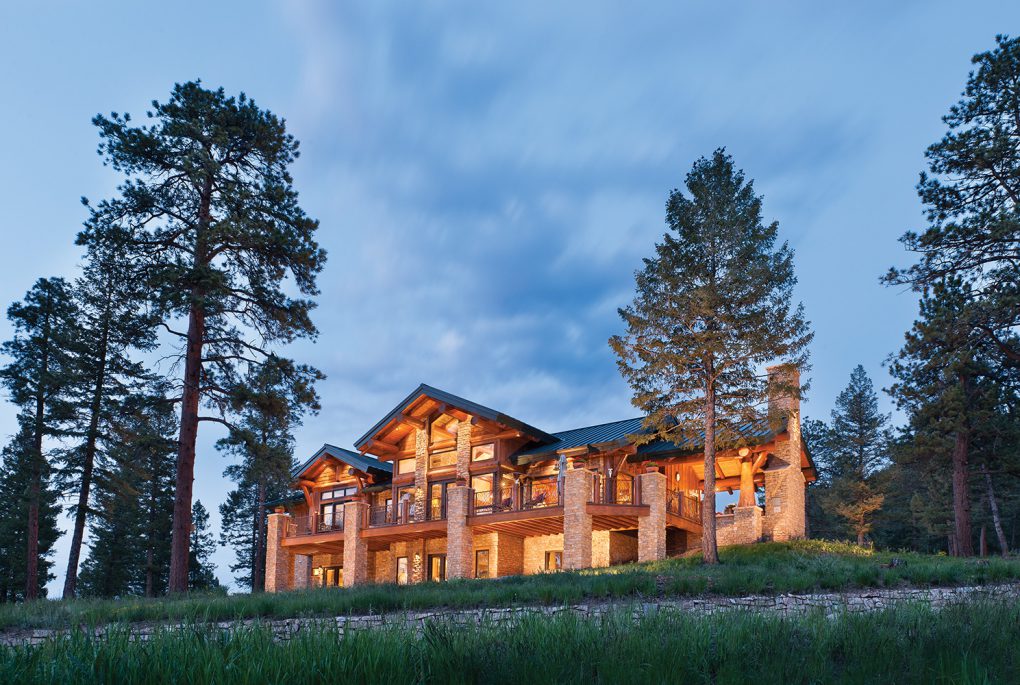
It may not surprise you to know that the most influential factor in log home fires is not the logs themselves but their physical location. Wildfires are a threat to all dwellings; however, a log home is far more likely to be located within their reach.
Start Your Dream Home Today with PrecisionCraft!
So how can you best protect your custom log or timber home from wildfires without moving it into the city? Two words: Defensible Space
According to the U.S. Department of Homeland Security and FEMA, “… defensible space is an area around a building in which vegetation, debris, and other types of combustible fuels have been treated, cleared, or reduced to slow the spread of fire to and from the building.” (FEMA, 2008)
We all know that fires need combustible materials (fuel) to spread. In response to a wildfire’s need for fuel, FEMA recommends creating three concentric zones of defensible space around your home. The amount of available fuel in each zone decreases as you get closer to your custom home. This article talks about FEMA’s recommended guidelines on the width of each zone. However, the zone width should increase as the risk of wildfire increases.

Zone 1
Zone 1 is located within 30 feet of your home. Clear all combustible material from this zone. This includes “… fire-prone vegetation, firewood stacks, combustible patio furniture, umbrellas, and dimensioned lumber decking.” (FEMA, 2008) In spite of this recommendation, Zone 1 does not need to be a dirt patch. The following are acceptable, and desirable, in Zone 1:
• Irrigated grass
• Rock gardens
• Stone patios
• Metal patio furniture
• Noncombustible decking
Zone 2
FEMA suggests that Zone 2 begin at 30 feet and end 100 feet from your home. Zone 2 should include only smaller clumps of fire-resistant, low growing landscaping which retains moisture. In other words, use fire-resistant landscaping. Click here for fire-resistant plant recommendations, and visit ReadyforWildfire.org for some tips on how to create fire-resistant landscaping.
Zone 2 may include woodpiles and separate structures such as detached garages, outdoor living structures, sheds, and the like. Another key point to remember: driveways and concrete or gravel patios and walkways are firebreaks. Since firebreaks may slow or stop the spread of a wildfire, incorporate them freely into your landscape design.
Zone 3
Located more than 100 feet from your log or timber home, Zone 3 is a transition area between the natural surroundings and the interior zones. As such, pruning and thinning vegetation, and removing dead plant material is the key to slowing the spread of wildfires.

It is important to remember that fire can spread vertically as well as horizontally. To limit the spread of fire vertically, CAL FIRE recommends using a minimum vertical clearance formula. Trim tree branches for a minimum 6-foot of clearance underneath. When planting shrubs under trees, make sure there is distance between the top of the shrub and the lowest tree branch. This distance should equal 3 times the height of the shrub.
In summary, defensible space will help protect your custom log and timber home in case of a wildfire. Since you may be able to create the defensible space yourself, it is an extremely cost-effective way to protect your investment. Defensible space is a definite win-win opportunity.
__________
CAL FIRE. (2016). Maintain Defensible Space. Retrieved from Wildfire is Coming… Are You Ready?: http://www.readyforwildfire.org/Defensible-Space/
FEMA. (2008, September). FS No. 4 – Defensible Space: Home Builder’s Guide to Construction in Wildfire Zones. Retrieved from FEMA: https://www.fema.gov/media-library-data/20130726-1652-20490-9209/fema_p_737_fs_4.pdf
